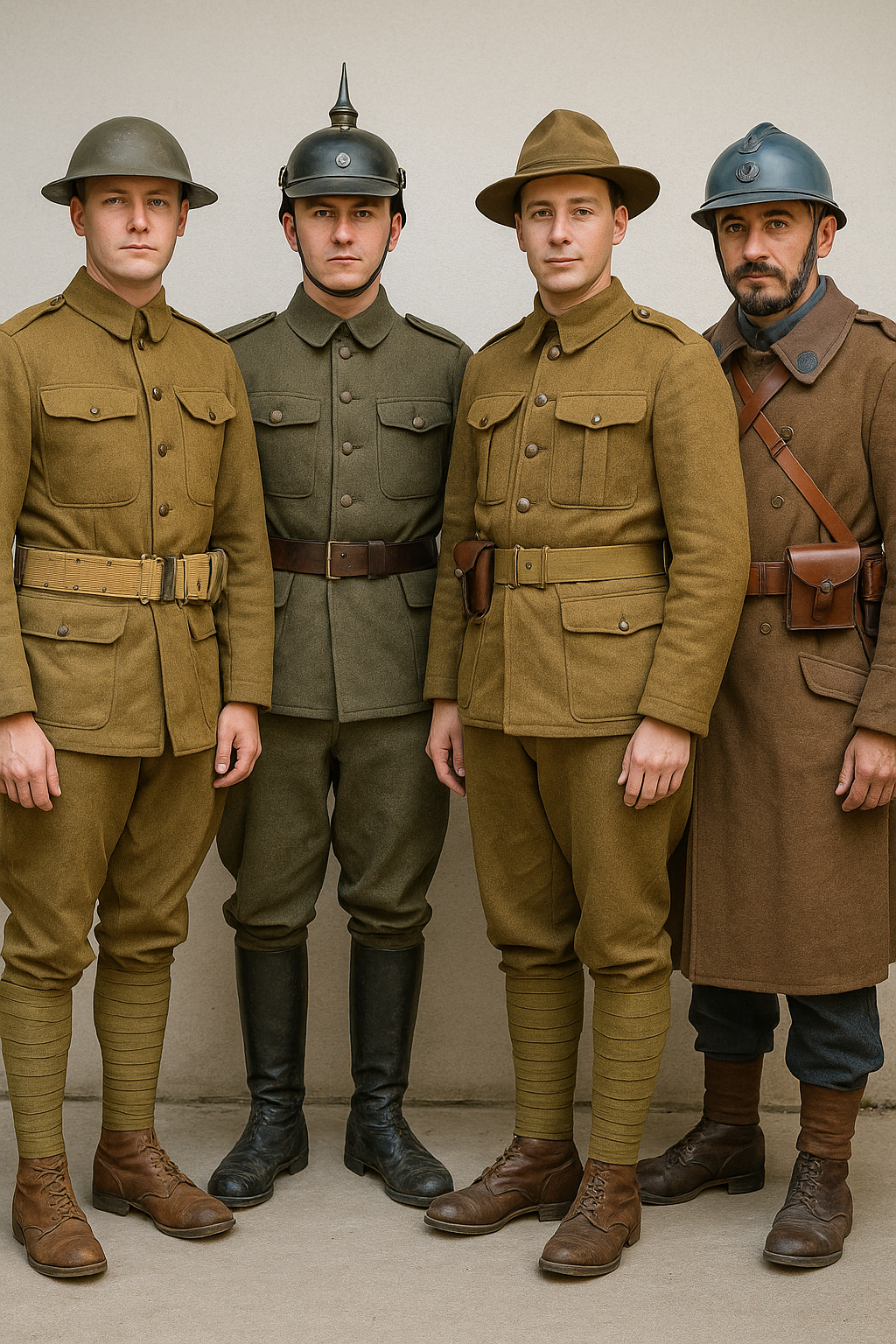
WW1 US Uniform and Global Military Styles: A Complete Guide to WWI and WWII Soldier Gear
Published on Oct 01, 2025
Introduction: Did You Know?
Did you know that during World War I, more than 4 million American soldiers wore the standard-issue WW1 US uniform? Yet, despite its iconic design, it often lacked comfort in the trenches compared to European gear.
For history buffs, collectors, and reenactors, understanding how WW1 uniforms varied by country opens a window into the culture, technology, and survival strategies of the era. From the rugged WW1 German uniform to the sharp look of the WW2 British soldier uniform, each nation’s gear tells a unique story.
This guide explores WW1 uniforms by country, with special focus on the WW1 US uniform. You'll learn:
- What made each uniform unique?
- How to identify authentic pieces vs. reproductions.
- Practical steps if you’re a collector or reenactor.
- Modern trends in uniform restoration and collecting.
WW1 US Uniform: The Icon of the Doughboy
The WW1 US uniform is one of the most recognisable in history. Nicknamed "Doughboys", American soldiers brought a mix of practicality and symbolism to the battlefield.
Key Features
- Wool Tunic (M1917): Olive drab, high-collar design.
- Trousers: Matching wool breeches tucked into puttees.
- Helmet: The British-inspired “Brodie” steel helmet.
- Boots: Trench boots, rugged but often prone to wear.
Actionable Tips for Collectors
- Look for original M1917 tunics; check stitching and material.
- Helmets with the original liner and chinstrap fetch a higher value.
- Avoid “aged reproductions” sold as originals—verify with serial numbers when possible.
Common Pitfall
Many beginners mistake WW1 US uniforms for early WW2 American uniforms—but note: WW2 jackets often had open collars and were paired with shirts and ties.
WW1 German Uniform: The Pickelhaube and Beyond
The WW1 German uniform is instantly recognisable with its early spiked helmet—the Pickelhaube.
Key Features
- Field-Grey (Feldgrau) Tunic: Practical camouflage against muddy battlefields.
- Pickelhaube Helmet: Iconic but later replaced with the sturdier Stahlhelm.
- Puttees and Jackboots: Protective yet heavy for trench conditions.
Collecting Insight
- Original Pickelhaube helmets are rare and highly collectible.
- Beware of reproductions made for reenactments—inspect age and leather condition.
Canadian Military Uniforms WW1: British Influence with a Twist
The Canadian military uniforms in WW1 largely followed British styles but had distinct markings.
Unique Details
- Service Dress Tunic: Khaki wool with Canadian insignia.
- Badges & Buttons: Often bore the maple leaf symbol.
- Headgear: Similar to British but often modified in the field.
Practical Steps for Enthusiasts
- Research regimental insignia for authenticity.
- Join Canadian military history forums for peer verification of gear.
WW2 British Soldier Uniform: Evolution from WW1
By WWII, the WWII British soldier uniform evolved into a more practical and modern design.
Features
- Battle Dress Blouse: Shorter, waist-length, wool jacket.
- Trousers: High-waist with large pockets.
- Helmet: Mark II helmet, replacing the Brodie.
Lessons for Collectors
- Ensure labels are intact; many uniforms were stamped with production dates.
- WWII British boots are often misidentified as WWI—look at the sole construction for accuracy.
WW2 French Uniform: Tradition Meets Modernization
The WW2 French uniform reflected a mix of tradition and urgency as France prepared for rapid mechanised warfare.
Key Features
- Horizon Blue (WWI carryover): Some troops still wore outdated sky-blue uniforms in 1940.
- Adrian Helmet: Distinctive French helmet with a crest.
- Brown Wool Tunic: More modern but varied due to supply shortages.
Actionable Step
If you’re reenacting, use authentic colour palettes—many reproductions get the “horizon blue” shade wrong.
Trends in Collecting and Reenactment Today
Modern history enthusiasts are increasingly:
- Digitally archiving uniforms with 3D scans.
- Using reproduction gear for reenactments while preserving originals.
- Collaborating with museums to authenticate and preserve fragile uniforms.
Pro Tip: If you’re starting a collection, begin with reproduction gear for reenactment, then slowly invest in authentic pieces for display.
Common Pitfalls for Beginners
- Mixing eras: Confusing WW1 US uniform pieces with WWII gear.
- Ignoring provenance: always check the documented history of an item.
- Buying online unthinkingly: Ask for multiple detailed photos before purchase.
- Not considering condition: A heavily restored item may lose collector value.
Conclusion: The Legacy of the WW1 US Uniform
The WW1 US uniform remains a powerful symbol of sacrifice and history. But when compared with the WW1 German uniform, Canadian military uniforms from WW1, and the later WW2 British soldier uniform and WW2 French uniform, it reveals a fascinating evolution of global military gear.
For collectors, reenactors, and history lovers, the key is to learn, verify, and preserve these relics. Whether you’re buying your first WW1 US uniform reproduction or researching an authentic German Pickelhaube, the journey is as rewarding as the discovery.
